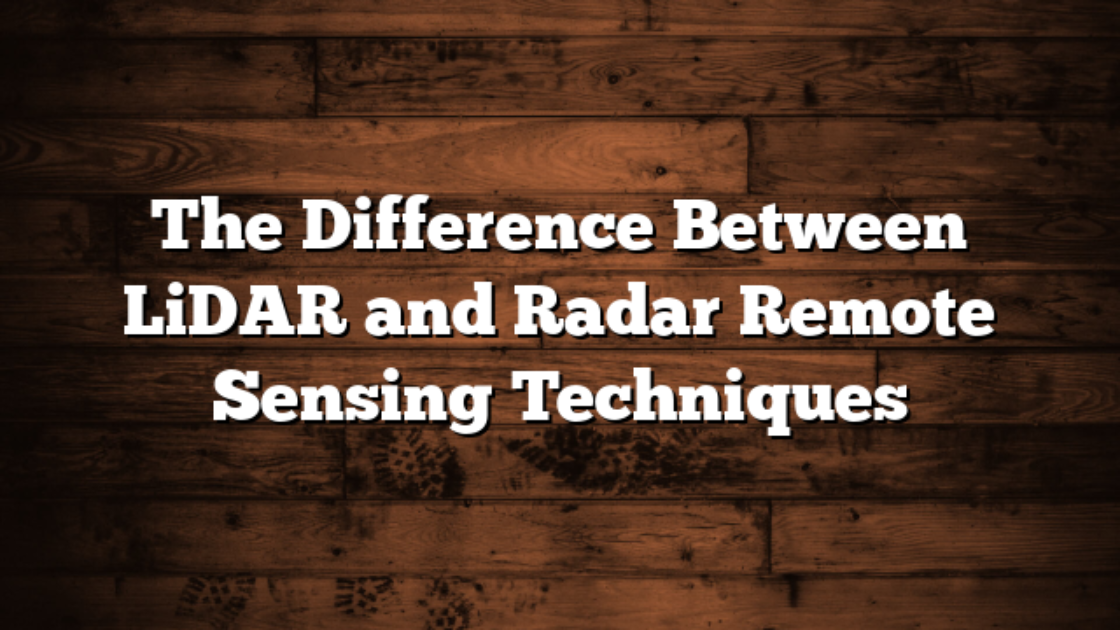LiDAR (Light Detection and Ranging) and radar are two remote sensing techniques that use different forms of energy to capture information about the Earth’s surface. Both techniques involve measuring the backscattered signal, but they differ in the type of energy used, operating principles, and data acquisition capabilities.
Energy Source
LiDAR uses laser pulses, while radar uses radio waves. Laser pulses have a shorter wavelength than radio waves, which gives LiDAR higher spatial resolution and accuracy. Radar, on the other hand, can penetrate various materials, such as vegetation and soil, making it suitable for subsurface analysis.
Operating Principle
LiDAR measures the distance to a target by measuring the time it takes for a laser pulse to travel to the target and back. This is known as the time-of-flight principle. Radar also uses the time-of-flight principle to measure distance, but it also measures the Doppler shift of the radar signal to determine the velocity of the target.
Data Acquisition
LiDAR captures the intensity and time-of-flight of laser pulses reflected by the target, generating high-resolution 3D point clouds. Radar measures the amplitude, phase, and Doppler shift of radar signals reflected by the target, providing information about target properties, surface roughness, or movement.
Comparison Table
| Feature | LiDAR Remote Sensing | Radar Remote Sensing |
|---|---|---|
| Energy Source | Laser pulses | Radio waves |
| Operating Principle | Measures the time-of-flight of laser pulses | Measures the time-of-flight and Doppler shift of radar signals |
| Data Acquisition | Captures the intensity and time-of-flight of laser pulses reflected by the target, generating high-resolution 3D point clouds | Measures the amplitude, phase, and Doppler shift of radar signals reflected by the target, providing information about target properties, surface roughness, or movement |
| Penetration Capability | Suitable for mapping and analyzing the surface features of objects and structures above the ground, including vegetation, buildings, and terrain | Can penetrate various materials, such as vegetation, soil, ice, or snow, to collect information about subsurface properties or hidden objects |
| Spatial Resolution | Provides high spatial resolution due to the narrow beamwidth of laser pulses, allowing for detailed mapping and identification of small-scale features | Offers variable spatial resolution depending on the radar system and operating frequency, with lower frequencies providing better penetration but lower resolution |
| Vertical Resolution | Provides high vertical resolution due to the precise timing of laser pulses, enabling the detection of fine elevation differences and surface roughness | Offers moderate to high vertical resolution, depending on the wavelength and system specifications, allowing for the detection of vertical structures and elevation changes |
| Data Applications | Widely used in applications such as topographic mapping, digital elevation modeling, vegetation analysis, urban planning, forestry, and flood modeling | Applied in various fields including land cover classification, soil moisture estimation, ice monitoring, oceanography, meteorology, and target detection in military or aerospace applications |
| Data Limitations | Sensitive to atmospheric conditions, such as fog or heavy rain, which can attenuate the laser signal and affect data quality | Affected by the dielectric properties of the target material, surface roughness, and interference from other radar sources, which can influence the accuracy and interpretation of radar measurements |
| Advantages | Provides accurate 3D measurements of the Earth’s surface, including vertical structures and fine details, suitable for high-resolution mapping and analysis | Offers all-weather capability, allowing data acquisition even in adverse weather conditions, and has the ability to penetrate vegetation and other materials for subsurface analysis |
| Limitations | Limited coverage area due to the narrow field of view and the need for direct line-of-sight between the sensor and the target | Lower spatial resolution compared to LiDAR and sensitivity to interference from other radar sources, limiting the detection of small-scale features |
Conclusion
LiDAR and radar remote sensing techniques are both valuable tools for capturing information about the Earth’s surface. The choice between LiDAR and radar remote sensing depends on the specific objectives, target properties, data requirements, and environmental conditions of the application.
LiDAR is suitable for high-resolution 3D mapping and analysis of above-ground objects and terrain. It is widely used in applications such as topographic mapping, digital elevation modeling, vegetation analysis, urban planning, forestry, and flood modeling.
Radar remote sensing provides the ability to penetrate materials and offers all-weather capabilities. It is applied in various fields, including land cover classification, soil moisture estimation, ice monitoring, oceanography, meteorology, and target detection in military or aerospace applications.

